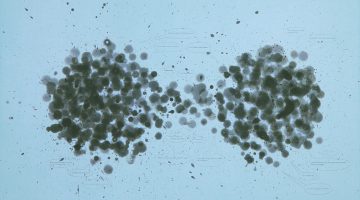
Installation image courtesy of Pier 24 Photography. (from left to right).
Andreas Gursky, F1 Pit Stop lll, 2007.
Edward Burtynsky, Socar Oil Fields #1a & #1b, Baku, Azerbaijan, 2006.
Andreas Gursky, 99 cent, 1999.
Time and space travel is happening, and it’s happening here in San Francisco. In their fifth exhibition, Pier 24 presents A Sense of Place. Images of the pyramids at Giza join sepia pictures of teepees standing on the banks of a river, views of 20th century Paris, and oversize color photos of men in suits soaking up the sun outside Rockefeller Plaza. Bringing together the work of 25 photographers and three galleries of images from the Sack Photographic Trust, this show explores the physical, mental, social and cultural meanings of a beguilingly simple word. Simple is never as it seems, and John Chiara’s orange-tinted diptych installed in the entrance to the show confirms this. Embarcadero at Interstate 80 reproduces the view just outside the door of tracks threading the space between two buildings underneath the span of the Bay Bridge. The inverted light and dark areas in this large-scale “negative” reflect the inversion of what’s expected and what’s delivered in a location at odds with traditional notions of an intersection.
The same sense of disconnect returns in the next room, where a monumental image of what looks like a light-filled hallway reveals itself to be the interior of a cardboard box with two cutouts for windows. The hallway to nowhere is actually an empty container that used to hold something. Other works in Room 4 provide similar difficulty and pleasure in placing oneself. An image of a locker room, empty save for a discarded cup, hanger and plastic bag, focuses on the unseen lives of built spaces. If no one is snapping towels or putting on gear in a locker room, is it still a locker room? A view of a flooded flatland filled with oil rigs and half-constructed buildings implicates the viewer in a polluted, apocalyptic scene where signs of human life seem to reside in the two mosques on a distant hilltop, if at all.
Place is political but also romantic or, more to the point, romanticized. Todd Hido’s large, blurred pictures of a buxom blond caught in the mist and of train trestles crossing a deserted road capture an anywhere, nowhere, anytime, once-upon-a-time. Aching with manufactured nostalgia, they contrast with images in the show that were once modern but have become antiquated, as the contemporary is wont to do. Lee Friedlander’s America by Car series and Stephen Shore’s Uncommon Places show the greasy spoon diners, empty country roads and small town churches that did and do characterize much of middle America. Antithetical to any careful choosing is the mountain of photos threatening visitors in Erik Kessels’ 24 HRS in Photos. The installation in which the artist downloaded and printed every image posted to Flickr in a 24-hour period is somehow both overwhelming and heartbreaking. Visitors can pick up strangers’ wedding photos and earnest selfies in a room that makes material the proliferation of digital content online. Acting like a jumbled photo album for a family of innumerable strangers, the piece underscores the democratization, over-use, utility, and self-indulgence characterizing photography as it stands today, when anyone with an Instagram account can be an image taker and tastemaker. It’s not Art but it’s art and there’s something powerful if not simultaneously distasteful or threatening in that freedom.
If this exhibition is meant to reveal how photographs shape the perception of our environment, it poses more questions than answers, as it should. Compounded by the space’s signature lack of wall text and labels bearing artists’ names, looking and seeing takes precedence over knowing. Pier 24’s approach privileges instinct over hard knowledge and encourages visitors to experience images at their own pace, unimpeded. It is tempting to write a review that excludes the identification of any artists and mimes the visitor’s experience.
Serving as both antechamber and exit to A Sense of Place, Eric William Carroll’s meditative diazotypes reproduce the sense of walking through a quiet wood. The installation of blue-tinted panels imposes calm and order through a unified composition and palette. Francesca Woodman’s statuesque, oversize self-portraits come to mind. Digitalization will march on, but the pleasure of sharing space with material objects that only exist in one time and place can’t be replicated. As William Carlos Williams warns in his review of Walker Evans’ American Photographs, “If we don’t see, hear, taste, smell and feel in this place – not only will we never know anything but the world of sense will be by that much diminished everywhere.”
The exhibition runs through May 2014. For more information visit here.
-Contributed by Ariel Rosen




